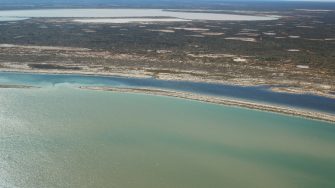
Date: Thursday, October 8, 2020
Project: Eastern Australian Waterbird Survey
Observers: Richard Kingsford UNSW, Paul Wainwright DEWHA
Pilot: James Barkell NSW National Parks & Wildlife Service DPIE
Again away early to head northwest to pick up some of the important wetlands in the Murray-Darling Basin, which don’t usually get that much attention. We began by surveying the extensive Yantabulla Swamp, sometimes known as the Cuttaburra Basin. This is a great wetland. We had heard that some flows had reached the wetland from Cuttaburra Creek, down the Warrego River, local rainfall and potentially the Paroo River. It receives water from all three sources. The bright green growth in the channels showed where the water had been but most of the wetland was dry, except for a relatively small area, about 10%, which was flooded in the northwestern corner of the wetland. It had hundreds of waterbirds, mainly grey teal and pink-eared duck but also swans, avocets, and glossy ibis. The shallow water is very productive. It’s not only the flooding of wetlands that is important but it is also the drying which is just as crucial because the warm waters are so productive and accessible to the waterbirds.
From there it was just a short flight over the border to survey the magnificent Currawinya Lakes, one of Australia’s most spectacular wetland systems. It was so great to see these two wetlands full for the first time in a long time. Their contrasting colours of blue and brown are amazing, reflecting the saline Lake Wyara and freshwater Lake Numalla.
The salt lake rapidly clears and allows sunlight to drive the production of a vegetation carpet under the water which is very productive. For this reason, as usual, Lake Wyara had about ten times more waterbirds that Lake Numalla.
So there were thousands of birds on the salt lake and only hundreds on the freshwater lake. Lots of swans were breeding on Lake Wyara and a small group of pelicans nesting on the island that they usually nest on.
There were hundreds of pink-eared ducks on Lake Numalla as well as cormorants. Once again, the Paroo River delivers for this wonderful internationally important wetland system, which is part of Currawinya National Park.
After refuelling at Bourke, we headed east along survey Band 5, over the Bogan River and onto the Macquarie Marshes. As usual, there were no waterbirds on the Bogan River and the odd waterbird on farm dams. When we got to the Macquarie Marshes, we did two surveys. The first concentrated on counts in the northern third of the Marshes, which intersected with our survey band and we have surveyed each October since 1983. We then did 10 fixed transects across the Marshes from north to south. This takes about an hour to do but gives a great estimate of the numbers of waterbirds in the whole Marshes.
The Marshes look great, even though it was a relatively small flood. As usual the contrast between flooded areas and those not flooded was stark. The water does everything for this wetland. There were lots of straw-necked ibis, Pacific herons, egrets, and glossy ibis as well as hundreds of grey teal and other ducks. It was also great to see the reed beds looking so green and watered.
There were no large breeding colonies of ibis, egrets or herons firing, although a few of the ducks were probably breeding, along with cormorants. We need a much bigger flood for this to happen. Burrendong Dam near Wellington needs to fill from rainfall around Bathurst and Mudgee for things to really happen out at the Marshes in terms of breeding and vegetation response. It is so great to see this wetland with water again after completely drying out in 2019.
At the top of the Marshes, we also surveyed one of the irrigation storages. Such a contrast in terms of biodiversity. This had no waterbirds compared to probably hundreds in the Marshes no more than a few kilometres away.
After the Marshes, we surveyed wherever there was water further to the east, including the odd farm dam and a very sorry and almost dry Namoi River. The wet season has not come to this part of the world. Further accentuating this, we surveyed a very low Split Rock Dam with hardly any water. We eventually finished up in Armidale.
Blog by Richard Kingsford
